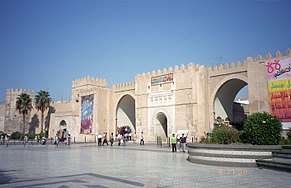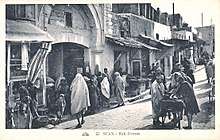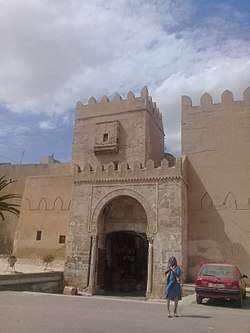Bab Diwan

Bab Diwan (Arabic: باب الديوان) or Bab Bhar (Door of the sea) (Arabic: باب بحر) is one of the gates of the medina of Sfax. It is located in the southern facade of the old city between Bab Kasbah on the western corner and Bab Borj Ennar on the east.[1]
Etymology
Bab Diwan got its name during the Hafsid era from the Arabic word Diwan (Arabic: الديوان) that refers to the customs administration, as Sfax had intense economical and commercial relations with other cities.[2]
Also, it is frequently called Bab Bhar as it opens on the sea.[3]
History

In the beginning, Bab Bhar was a normal gate for passengers with the same form as Bab Jebli in the northern facade of the Medina. Yet, considering its geographical localization that made it more exposed to attacks, the gate benefited during the 17th century from improvements being made to the defenses of Sfax and got more fortified. The access to the inside of the city through this entrance was difficult, and before the 20th century modifications, every passenger taking it to enter the medina had to turn right and walk through a narrow alley inside the wall for about 30 meters before turning left and reaching the inside.
This design was set up for security reasons because even if the outer gate could be battered open, the invaders would have been vulnerable to attack from above as they worked on the inner gate, at which they would have very little room for maneuvre for their equipment.[1]
Entrances of Bab Diwan
Originally, the gate was the only one in Sfax facing the sea. Later, three other such gates were added over the years in order to adapt to the development of the community inside the city.

The original gate
The oldest entrance in Bab Bhar is part of a wall section that projects out from the main line of the wall.
It is composed of two doors: an outer one (currently the one located in the west of the facade) and an internal one facing Ajouzine Mosque.[4] To reach the inside of the city, passengers have to go through the external door and two sheds: one in the east and the second in the south. These sheds that were originally payment points for the customs, are currently occupied by merchants.
In April 1885, the municipality built added a minaret with a clock, but it was destroyed later during the bombing raids of the second world war in 1942.
 The inner door with Ajouzine Mosque in the back
The inner door with Ajouzine Mosque in the back The outer entrance
The outer entrance Inscription on top of the door
Inscription on top of the door Shops inside the sheds
Shops inside the sheds The tower on top of the original gate
The tower on top of the original gate
The France door
In 1904, the french minister Delcassé visited the medina and noticed offset alignment and the darkness of the alley linking the outer and inner entrances. So by 1909, a new additional entrance "porte Delcassé" or "porte de France" was added facing the inner entrance of the original gate. This allowed traffic, pedestrians and commercial goods being delivered by barrows and granted easier access to the medina.[1]
This gate represents the central entrance in Bab Diwan between the two big entrances added after the independence.
 Bab Diwan with Porte De France in the 20th century
Bab Diwan with Porte De France in the 20th century Delcassé Gate
Delcassé Gate
The independence gates
During the country's independence period, two large entrances were added allowing unprecedented access to the medina for the vehicles in 1963:
- One between the original door and the France door, separating the sheds
- One in the east of Bab Diwan over the ruins of a small door that was discovered later in 1953[5]
 Arch of the new entrance
Arch of the new entrance The vehicular entrances with the France door in the center
The vehicular entrances with the France door in the center Bab Diwan in 1954
Bab Diwan in 1954 Bab Diwan in 1960
Bab Diwan in 1960
Gate Diagram
| Wikimedia Commons has media related to Bab Diwan. |
The level of pavement inside the gate is actually lower than that of the plaza outside. The cobbled path that leads between the two gates has a kerb at both sides, but is interrupted by the western of the two vehicle entrances. The cobbles and kerbs continue in the central block of wall that forms the rest of Bab Diwan. Their construction required the demolition of the section of wall they occupy - walls that had been rebuilt after World War II collateral damages.[1]
References
- "Sfax Through the Ages". www.edusfax.com. Retrieved 2017-12-15.
- Abdelkafi, Boubaker. History of Sfax. p. 34.
- Clark, Peter. "Une histoire de Bab Diwan". www.lesitesfaxien.net (in French). Retrieved 2017-12-15.
- Abdelkafi, Boubaker. History of Sfax. pp. 50–52.
- Abdelkafi, Boubaker. History of Sfax. pp. 50–52–53.